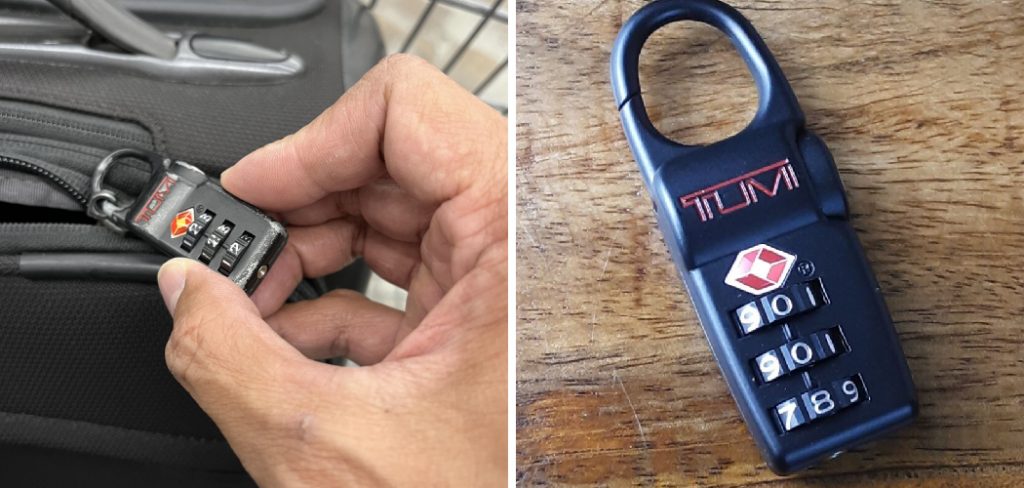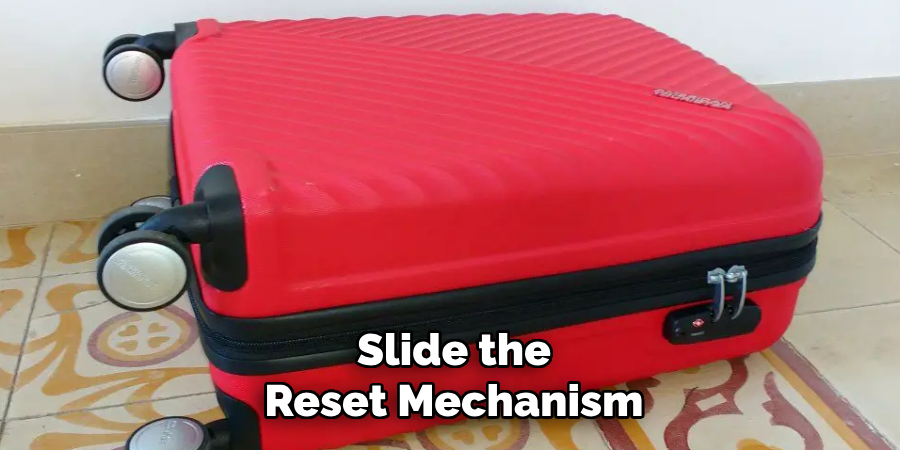Setting a Tumi lock is an essential step to ensure the safety and security of your belongings while traveling. Whether you have a combination lock or a key lock, understanding how to properly set and use it will give you peace of mind during your trips. This guide will walk you through the process of How to Set Tumi Lock.

What is a Tumi Lock?
A Tumi lock is a specialized locking mechanism designed for Tumi luggage to provide added security for your belongings. These locks are typically TSA-approved, allowing Transportation Security Administration agents to open and inspect your luggage without damaging the lock during security checks. Tumi locks come in various forms, such as combination locks and key locks, ensuring that travelers can choose an option that best fits their needs. With its durable design and user-friendly features, a Tumi lock helps protect your valuables while ensuring convenient access for authorized personnel.
Why Set a Tumi Lock?
Setting a Tumi lock on your luggage is a simple yet effective way to enhance your travel security. By securing your belongings with a reliable lock, you reduce the risk of theft or unauthorized access during your trip. Tumi locks offer peace of mind, especially when navigating crowded airports, train stations, or hotels. Additionally, their TSA-approved design ensures that your luggage can be inspected by security personnel without causing damage to the lock or your bag. Establishing a combination or setting up the lock is straightforward, making it a hassle-free option for travelers seeking added protection and convenience.
Types of Tumi Locks
Tumi offers a variety of lock types to suit different travel needs and preferences. One popular option is the combination lock, which allows users to set a personalized code for quick and secure access without the worry of losing a key. Another common choice is the key lock, ideal for travelers who prefer a traditional locking mechanism or who may find remembering combinations inconvenient.
For those seeking advanced security, Tumi also provides electronic locks featuring innovative technology, such as fingerprint recognition or smartphone app integration, combining modern convenience with maximum protection. Many models are TSA-approved, ensuring compliance with travel regulations while safeguarding your belongings. These options make it easy for travelers to find a lock that meets their specific requirements.
10 Methods How to Set Tumi Lock
1. Familiarize Yourself with the Lock Type

Before setting the lock on your Tumi luggage, it’s important to know what kind of lock it has. Most Tumi bags come with a TSA-approved combination lock, which allows security personnel to open the lock without damaging it. Some Tumi bags also feature a traditional combination lock or even a key-based locking system. Depending on the model, you might need to adjust the lock by setting a new combination code. Make sure to identify the exact type of lock on your Tumi bag before proceeding with any adjustments.
2. Locate the Lock on Your Tumi Bag
Typically, the lock on your Tumi bag will be located on the zipper or the side of the luggage. It may be integrated into the handle or attached via a small loop. For suitcases, the lock is usually placed on the front or top of the bag, while on briefcases, it may be hidden inside a compartment or along the outer edge. Familiarize yourself with the lock’s location so you can access it easily when you’re ready to set the combination.
3. Ensure the Lock is in the ‘Open’ Position
Before you can set the combination on your Tumi lock, it must be in the “open” position. This means the lock should not be secured to the zipper or any fastener that prevents the locking mechanism from moving. If the lock is currently in a locked state, you need to open it first. Typically, for TSA locks, you will need to pull up or push down the locking mechanism to unlock it. Once the lock is open, you’ll be able to set your combination.
4. Locate the Reset Button or Lever
On most Tumi locks, a small reset button or lever is located near the dial. This is a critical part of the process for setting the lock, as it allows you to change the combination code. Some models have a small button that needs to be pushed in with a pen or paperclip, while others have a lever that you can slide to enter the reset mode. Make sure to identify this button or lever before proceeding with the reset process.
5. Press or Slide the Reset Mechanism

Once you’ve located the reset button or lever, you’ll need to engage it to begin the process of setting your new combination. If the lock has a button, use a pen or another small tool to press it. For models with a lever, simply slide it to the “reset” position. When you activate the reset mechanism, the dials will become disengaged from the current combination, allowing you to change the code. Keep the reset mechanism pressed or in the “reset” position as you continue with the next steps.
6. Set Your Desired Combination
Now that you’ve engaged the reset mechanism, it’s time to set your new combination. Tumi locks typically have a three-digit combination. Use the dials on the lock to rotate them to your desired numbers. Ensure that each number is selected carefully and that you can remember the sequence. If you’re setting a new code for security reasons, choose a combination that’s not easy to guess, such as a series of random numbers or a sequence that has personal significance to you. It’s also helpful to write the combination down in a secure location in case you forget it.
7. Test the Combination Before Finishing
Once you’ve set your desired combination, it’s essential to test the lock to ensure the new code works correctly. Move the dials away from the selected numbers, and try to unlock the bag with the combination you just set. If the lock opens without any issues, this confirms that the combination is correctly set. If the lock doesn’t open, double-check the numbers and ensure the dials are aligned precisely with your chosen sequence. Make adjustments as needed and test again.

8. Return the Reset Button or Lever to its Original Position
After successfully setting and testing the combination, you must return the reset button or lever to its original position to finalize the process. If you used a reset button, release it and allow the dials to lock back into place. If you used a lever, slide it back to the original locked position. This will secure your new combination in place and ensure that the lock is functioning correctly. Once the reset mechanism is back in its default position, the lock should now be set with your newly chosen combination.
9. Record the Combination in a Secure Location
It’s crucial to keep track of your new combination in case you forget it. Write down the combination and store it in a secure place, such as a password manager, a locked drawer, or a private, easily accessible notebook. Do not store the combination inside the luggage itself, as that defeats the purpose of having a secure lock. Some people also opt to store their combination in a trusted digital format, such as encrypted files or a secure cloud-based storage service.
10. Ensure Regular Maintenance and Use of the Lock
Once your Tumi lock is set, it’s essential to maintain it for optimal performance. Regularly check the lock for any signs of wear, such as difficulty turning the dials or issues with the locking mechanism. If the lock becomes stiff or hard to use, consider applying a small amount of graphite powder or lubricant to the locking mechanism to keep it functioning smoothly.

Additionally, ensure that the combination is always kept secure, and avoid sharing it with others unless absolutely necessary. Over time, as you continue to use the bag, you may want to change the combination again for added security. Always follow the manufacturer’s instructions for resetting the lock if you decide to change the combination.
Maintenance and Upkeep
Proper maintenance is essential to ensure the longevity and functionality of your bag. Regularly inspect the bag for signs of wear and tear, such as frayed straps, damaged zippers, or worn seams. Clean the bag according to the manufacturer’s instructions, typically using a damp cloth and mild soap to remove dirt and stains. Avoid overloading the bag, as excessive weight can strain the material and compromise its durability. If your bag comes with leather accents, consider using a leather conditioner to prevent cracking and keep the material supple. By taking these simple maintenance steps, you can keep your bag in excellent condition for years to come.
Conclusion
Setting the lock on your Tumi luggage is a simple but essential task that ensures your belongings remain secure while traveling. By following these 10 steps, you can easily set or reset your Tumi lock to a combination that works best for you. Remember to carefully choose a secure combination, test it, and store it in a safe location to avoid any future inconvenience. Thanks for reading, and we hope this has given you some inspiration on how to set tumi lock!
About
Safety Fic is a distinguished figure in the world of Diy design, with a decade of expertise creating innovative and sustainable Diy solutions. His professional focus lies in merging traditional craftsmanship with modern manufacturing techniques, fostering designs that are both practical and environmentally conscious. As the author of diy, Safety Fic delves into the art and science of Safety Fic-making, inspiring artisans and industry professionals alike.
Education RMIT University
(Melbourne, Australia) Associate Degree in Design (Safety Fic) Focus on sustainable design, industry-driven projects, and practical craftsmanship. Gained hands-on experience with traditional and digital manufacturing tools, such as CAD and CNC software.
Nottingham Trent University
(United Kingdom) Bachelor’s in diyfastly.com and Product Design (Honors) Specialized in product design with a focus on blending creativity with production techniques. Participated in industry projects, working with companies like John Lewis and Vitsoe to gain real-world insights.
Publications and Impact
In diy, Safety Fic his insights on indoor design processes, materials, and strategies for efficient production. His writing bridges the gap between artisan knowledge and modern industry needs, making it a must-read for both budding designers and seasoned professionals.
